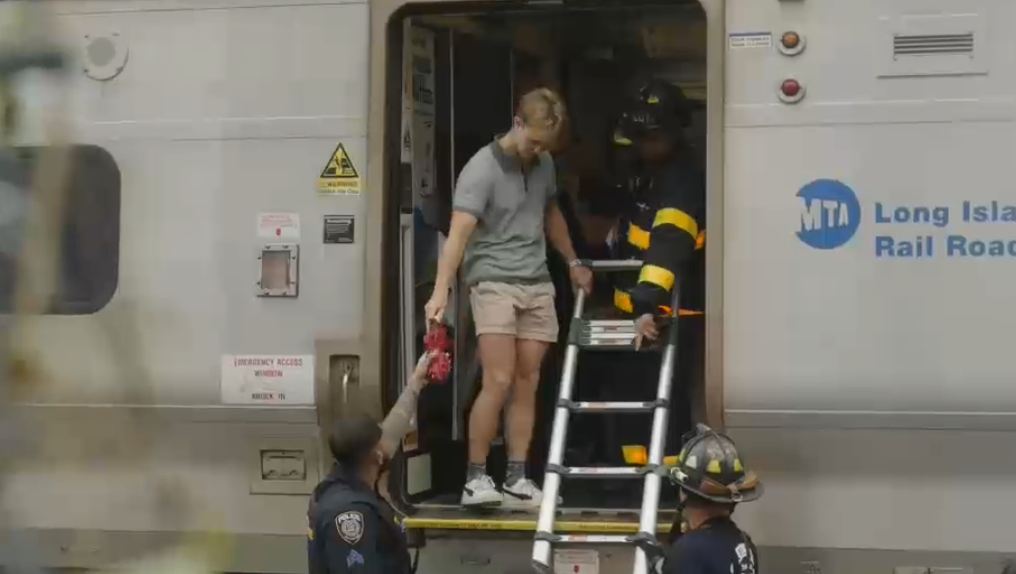(New York City, August 1, 2025) – For the second time in weeks, torrential rains unleashed catastrophic flash flooding nyc across the Tri-State area Thursday, turning highways into rivers, trapping commuters in submerged vehicles, and claiming at least one young life in Maryland. Governors Kathy Hochul (NY) and acting Governor Tahesha Way (NJ) declared states of emergency as rainfall rates hit a staggering 3 inches per hour—overwhelming aging infrastructure and paralyzing 50 million residents during evening rush hour.
By nightfall, unofficial rainfall totals reached 1.92 inches on Staten Island, 1.37 inches in Brooklyn, and a devastating 5 inches in Queens, with water levels at Catherine Court and Jewett Avenue hitting 21.3 inches deep. The National Weather Service confirmed this was the region’s third major flood event in July alone.
Crisis on the Streets: Vehicles Abandoned, Highways Submerged
Chaos erupted by mid-afternoon as floodwaters surged:
- Queens’ Clearview Expressway transformed into a lake, stranding drivers on car roofs amid submerged sedans and semi-trucks. Emergency crews performed 15+ high-risk rescues as waist-deep currents swept across the highway.
- Manhattan’s FDR Drive shut down entirely at Houston Street after water submerged tires, reducing traffic to 2 mph. Simultaneously, a tree crashed onto Q train tracks in Brooklyn, halting servic.
- 110 commuters were evacuated from a flooded Long Island Rail Road train in Bayside after water engulfed tracks, trapping passengers for two hours.
“I’ve issued a state of emergency. Don’t drive. Roadways are flooding. If you live in a basement apartment, move to higher ground NOW.”
— Mayor Eric Adams via social media, 5 PM Thursday
Transit Systems Drowned: Subways to Airports Paralyzed
New York’s fragile infrastructure buckled under the deluge:
- Subways: Grand Central Terminal’s Metro-North trains resembled “a car wash,” with water cascading onto platforms. The MTA suspended 1/2/3 lines after brown water burst from grates at 23rd Street Station, flooding turnstiles and platforms.
- Air Travel: 1,439 flights canceled nationwide—332 at LaGuardia alone. JFK faced 3-hour delays, while DC-area airports issued ground stops.
- Rail: Amtrak halted Philadelphia-Wilmington service due to submerged tracks. NJ Transit reported overhead wire failures, stranding thousands.
Human Toll: A Child Lost, Communities on Edge
Tragedy struck in Mount Airy, Maryland, where a child playing outdoors was swept into a drainage pipe by flash floods. Fifty responders fought waist-deep currents for an hour before recovering the victim, who succumbed to drowning. The death echoed flooding two weeks prior that killed two in Plainfield, New Jersey—a town still recovering when Thursday’s rains hit.
“The rushing water pushed him into this pipe… Rescuers fought the current trying to get him out.”
— Mount Airy Volunteer Fire Company spokesperson
Why This Keeps Happening: Climate Change’s Fingerprints
Meteorologists confirm a vicious cycle accelerating flash flooding nyc:
- Saturated Ground: Summer rainfall is 30-50% above normal in the Mid-Atlantic, leaving soil unable to absorb more water.
- Warmer Atmosphere: Climate change enables air to hold 3-4% more moisture per 1°F of warming, fueling extreme downpours. Hourly rainfall rates surged in 90% of major U.S. cities since 1970.
- Aging Infrastructure: NYC sewers handle only 1.75 inches/hour—far below Thursday’s rates. Clogged catch basins worsened flooding in low-lying areas like East Flatbush.

EmerEmergency Response: What’s Next?
As of Friday morning:
- NYC’s state of emergency remains until 8 AM, with alternate-side parking suspended.
- Con Edison crews work to restore power to 1,568 customers, mostly in Brooklyn and Staten Island.
- Flood risk shifts south to Carolinas/Georgia, though scattered showers may linger in NYC.
Safety Checklist for New Yorkers:
✅ Evacuate basements immediately—floods can fill spaces in minutes
✅ Avoid all travel until waters recede
✅ Clear debris from drains/gutters near your home
✅ Sign up for Notify NYC alerts
✅ Never walk/drive through floodwaters—6 inches knocks adults down; 2 feet floats cars
Building Resilience in a Wetter World
This summer’s relentless floods expose a harsh reality: infrastructure built for 20th-century climates can’t withstand 21st-century extremes. As Acting New Jersey Governor Tahesha Way noted, “Flash flooding is becoming our new normal.”
While FloodNet NYC’s real-time sensors and the city’s Flash Flood Emergency Plan are critical, the NYC Department of Environmental Protection estimates $30 billion is needed for drainage upgrades and flood-resistant buildings. With climate models predicting more frequent deluges, the time for adaptation is now.
